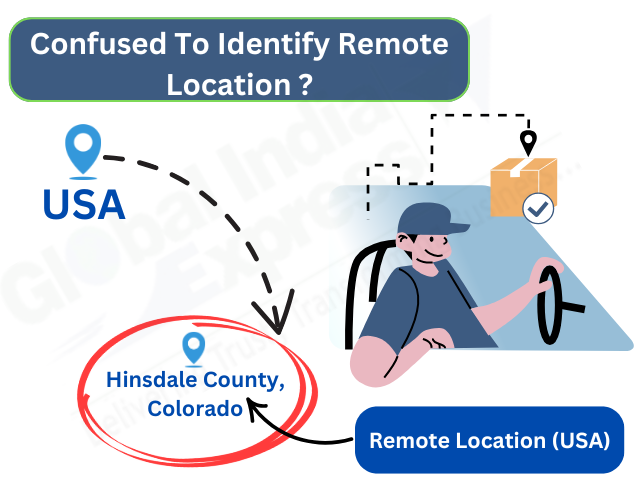
International Remote Area Delivery Charges
International Remote Area delivery charges are a crucial yet often overlooked aspect of global shipping. These fees are imposed by logistics companies to compensate for the additional challenges and costs associated with delivering goods to hard-to-reach areas. This article dives into the intricacies of remote area delivery fees, including why they’re levied, how they’re calculated, and ways to avoid them. It also provides insights into country-specific charges and explains how Global India Express handles these fees.
What Are International Remote Area Delivery Fees?
International Remote Area fees are surcharges applied by shipping carriers when goods are delivered to locations that are hard to access, far from urban hubs, or lack proper infrastructure. Logistics providers, including Global India Express, DHL, FedEx, and UPS, impose these fees to offset the extra time, fuel, and resources required for such deliveries.
Common carriers classify remote areas based on factors like distance from their main hubs, road access, and delivery volume. While these charges might seem inconvenient, they ensure that even the most isolated locations receive services.
Why Are International Remote Area Charges Levied?
Shipping carriers incur significant additional expenses when delivering to remote areas. The key reasons include:
- Distance and Accessibility: Reaching remote locations often involves longer travel distances and navigating difficult terrain.
- Higher Fuel Costs: Fuel usage increases due to longer trips and less efficient routes.
- Low Delivery Volume: With fewer shipments heading to remote regions, the cost per package is higher.
- Infrastructure Limitations: Remote areas might lack proper roads, increasing the complexity of delivery.
These charges are essential to maintain a balance between service quality and operating costs, ensuring carriers can reach customers worldwide.

Why Are International Remote Area Charges Levied?
Shipping carriers incur significant additional expenses when delivering to remote areas. The key reasons include:
- Distance and Accessibility: Reaching remote locations often involves longer travel distances and navigating difficult terrain.
- Higher Fuel Costs: Fuel usage increases due to longer trips and less efficient routes.
- Low Delivery Volume: With fewer shipments heading to remote regions, the cost per package is higher.
- Infrastructure Limitations: Remote areas might lack proper roads, increasing the complexity of delivery.
These charges are essential to maintain a balance between service quality and operating costs, ensuring carriers can reach customers worldwide.
International Remote Area Charges by Global India Express
Global India Express provides a transparent breakdown of remote area fees based on destination. Their pricing structure considers factors such as distance, delivery frequency, and package weight. By leveraging their extensive network, they aim to minimize these charges whenever possible.
How to Assess International Remote Area Charges?
- Online Tools: Many logistics companies, including Global India Express, offer online calculators to determine whether an address is classified as remote.
- ZIP Code Checks: Specific ZIP codes or postal codes are often listed as remote by carriers.
- Customer Support: Contacting customer service can help clarify any ambiguities regarding remote area classification.
- Factors Influencing Remote Area Charges
- The following elements can impact remote area fees:
- Geographical Distance: Farther locations naturally incur higher costs.
- Route Complexity: Difficult terrains or lack of direct access increase expenses.
- Delivery Volume: Lower shipment volumes to remote areas drive up costs.
- Carrier-Specific Policies: Each logistics provider has unique definitions for remote zones.
How to Avoid International Remote Area Delivery Fees
While it’s challenging to eliminate remote area charges completely, businesses and individuals can take steps to minimize them:
- Use Nearby Hubs: Ship packages to a nearby urban location for pickup.
- Negotiate Discounts: Partner with logistics providers offering lower remote fees.
- Consolidate Shipments: Combine multiple shipments into one to reduce costs.
Countries with International Remote Area Delivery Charges
USA
In the United States, remote delivery fees primarily apply to regions like Alaska, Hawaii, and isolated rural areas. Certain ZIP codes in mountainous or desert regions may also incur surcharges.
Australia
With vast outback regions and island communities, Australia frequently faces remote delivery challenges. Deliveries to Western Australia or areas beyond major cities like Sydney and Melbourne typically attract fees.
Canada
Northern territories, including Yukon and Nunavut, are classified as remote due to their harsh conditions and lack of accessible infrastructure.
UK
Remote delivery fees in the UK focus on regions like the Scottish Highlands, Isles of Scilly, and smaller island communities.
France
Corsica and sparsely populated rural areas are subject to additional charges.
UAE
Remote areas in the UAE include desert regions or locations far from major cities like Dubai and Abu Dhabi.
Spain
Deliveries to the Canary Islands, Balearic Islands, and certain rural mainland areas may incur surcharges.
Germany
Remote delivery fees apply to mountainous regions and less-populated countryside zones.
Netherlands
Isolated rural areas in the Netherlands are considered remote by many carriers.
New Zealand
The South Island and remote coastal towns often attract additional delivery fees.
China
Far-flung provinces like Tibet or regions with challenging terrain are classified as remote areas.
Singapore
While small in size, Singapore’s offshore islands occasionally attract remote delivery fees.
International Remote Area Charges Price Table by Country
Below is a sample table of remote area delivery charges, showcasing approximate costs for shipping to remote regions in various countries. The prices are indicative and may vary based on the logistics carrier, package weight, and delivery service (e.g., express, standard).
| Country | International Remote Area Examples | Approx. Charge (USD) | Additional Notes |
|---|---|---|---|
| USA | Alaska, Hawaii, Montana, rural ZIPs | $30–$50 | Fees vary by carrier and exact location (e.g., mountains or rural towns). |
| Australia | Outback regions, Tasmania | $40–$70 | Deliveries to remote islands or far inland areas may attract higher fees. |
| Canada | Yukon, Nunavut, Northern Territories | $50–$80 | Charges are higher for deliveries to regions with limited infrastructure. |
| UK | Scottish Highlands, Isles of Scilly | $25–$40 | Mainland rural deliveries may also incur a surcharge. |
| France | Corsica, rural countryside | $20–$35 | Deliveries to island territories tend to be costlier. |
| UAE | Desert regions, outskirts of Abu Dhabi | $25–$50 | Remote fees vary based on accessibility of the delivery area. |
| Spain | Canary Islands, Balearic Islands | $30–$55 | Higher fees for deliveries to offshore islands. |
| Germany | Alpine regions, rural Bavarian areas | $20–$40 | Low shipment volume to these areas increases costs. |
| Netherlands | Northern islands, rural towns | $15–$30 | Charges are relatively low compared to larger countries. |
| New Zealand | South Island, remote coastal areas | $40–$70 | Deliveries to smaller islands may incur additional costs. |
| China | Tibet, remote mountainous provinces | $50–$100 | Some locations may require additional customs or special handling fees. |
| Singapore | Offshore islands (e.g., Pulau Ubin) | $20–$35 | Fees depend on accessibility and mode of transportation. |
Additional Notes on Pricing:
- Weight-Based Pricing:
Many logistics providers calculate remote area fees based on package weight. Heavier parcels may attract higher charges. - Carrier-Specific Pricing:
- DHL Remote Area Fee: Typically starts at $25 and can increase depending on location.
- FedEx Remote Area Fee: Approximately $30–$50 for most locations.
- UPS Remote Area Fee: Averages $35–$60 based on distance and accessibility.
- Global India Express: Fees start at $20–$40, offering competitive rates.
- Flat Fees vs. Variable Rates:
Some carriers use flat fees for specific regions, while others calculate based on distance, terrain, or service type.
By assessing fees with tools provided by logistics companies, customers can make cost-effective decisions while shipping to remote areas.
Frequently Asked Question – International Remote Area
FAQs on Remote Area Charges and Delivery Services
1. What are remote area charges?
Remote area charges are additional fees imposed by courier companies like DHL, FedEx, UPS, and USPS for delivering shipments to areas that are far from their main hubs or difficult to access due to poor infrastructure, distance, or low delivery volumes.
2. What does remote area delivery mean?
Remote area delivery refers to shipments sent to isolated or rural locations that are harder to reach. These areas often require extra resources, longer transit times, or special handling, which result in additional charges.
3. What are DHL remote area charges in India?
For deliveries to remote locations in India, DHL applies remote area charges based on the location’s distance from their service hubs. These charges typically range from ₹2,500–₹5,000 or more, depending on the shipment’s weight and destination.
4. How can I check if my location is a remote area for DHL?
You can check if your address falls under DHL’s remote area category by using the DHL Remote Area Locator Tool available on their website. Simply input the postal code or city to verify if additional charges apply.
5. What is the DHL remote area list?
The DHL remote area list is a catalog of ZIP codes and locations globally identified by DHL as remote or hard-to-reach. This list is periodically updated and includes locations in India, the USA, Australia, and other countries.
6. How do I check UPS remote areas?
UPS provides an online Remote Area Checker Tool on their website, allowing users to enter the postal code to see if it’s classified as remote. UPS also publishes a list of remote regions, which can be downloaded for reference.
7. How are remote area charges calculated?
Remote area charges are typically calculated based on:
- Distance from the nearest hub.
- Package weight and dimensions.
- Location-specific surcharges.
Charges may also be applied per kilogram, with rates ranging from $2–$5/kg or a flat fee.
8. What are FedEx remote area charges?
FedEx imposes remote area charges for deliveries to less accessible areas. These charges start from $20–$50 and may increase based on the package weight and the specific location.
9. Do USPS shipments include remote area charges?
USPS generally does not levy explicit remote area charges like private couriers. However, delivery times may be longer for rural or isolated areas, and some locations may have higher base shipping rates.
10. How can I reduce remote area charges for international shipping?
Here are some tips to minimize remote area charges:
- Consolidate shipments to reduce overall fees.
- Ship to a nearby urban hub and arrange local pickup.
- Partner with logistics companies like DHL or FedEx to negotiate discounted rates.
- Use carriers that have lower remote charges for your destination.
11. What are remote area medical deliveries?
Remote area medical deliveries refer to the shipment of medical supplies to isolated or rural locations. Couriers often prioritize such shipments due to their critical nature, but they may still levy remote area charges.
